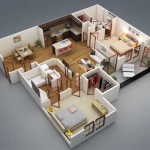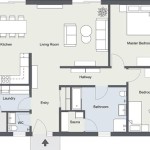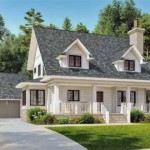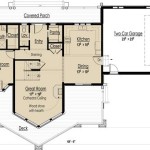The Enduring Appeal and Practical Considerations of Modern House Open Floor Plans
Open floor plans have become a defining characteristic of modern residential architecture. The concept, which removes or minimizes walls between living spaces such as the kitchen, living room, and dining area, offers a sense of spaciousness and connectivity. This design choice has gained popularity for its perceived benefits in facilitating social interaction and creating a more versatile living environment. However, the adoption of an open floor plan also presents certain practical challenges that require careful consideration during the design and construction phases.
The prevalence of open floor plans can be attributed to several factors. Changing lifestyles, with an increased emphasis on casual living and entertaining, have influenced homeowners' preferences. The desire for a more integrated living space, where family members can interact while performing different activities, is a driving force. Furthermore, open floor plans are often associated with a contemporary aesthetic, aligning with current design trends that prioritize minimalism and seamless transitions between spaces.
The rise of open floor plans is also intertwined with advancements in building technology. Modern construction techniques allow for longer spans and fewer load-bearing walls, making it easier to create large, uninterrupted spaces. The availability of cost-effective and aesthetically pleasing structural support systems has further contributed to the feasibility and popularity of this design approach.
Enhanced Social Interaction and Communication
One of the primary advantages cited for open floor plans is their ability to foster social interaction and communication within the household. By eliminating physical barriers, family members can remain connected while engaged in different activities. This is particularly beneficial for families with young children, as parents can easily supervise their children while preparing meals or performing other tasks. The open flow also facilitates conversation and interaction during gatherings, making it easier for guests to mingle and feel included in the activities.
The visual connectivity offered by an open floor plan promotes a sense of togetherness and shared experience. Family members are more likely to engage with one another when they can see and hear each other. This can lead to stronger bonds and a more cohesive family dynamic. The open layout also encourages spontaneous interaction, as individuals are more likely to strike up a conversation or participate in an activity if they are within close proximity to one another.
However, it is important to acknowledge that not all individuals thrive in open environments. Some people require more privacy and personal space, and an open floor plan may not be suitable for those who prefer a more secluded living arrangement. It is crucial to consider the individual needs and preferences of all household members when deciding whether to adopt an open floor plan.
Increased Natural Light and Improved Airflow
Open floor plans often result in increased natural light penetration throughout the living space. With fewer walls obstructing the flow of light, natural light can reach deeper into the interior, creating a brighter and more inviting atmosphere. This can have a positive impact on mood and well-being, as exposure to natural light is known to improve alertness and reduce stress. The increased natural light also reduces the need for artificial lighting, which can lead to energy savings and a lower carbon footprint.
Furthermore, open floor plans can facilitate improved airflow and ventilation. The absence of walls allows for the free circulation of air, which can help to regulate temperature and reduce humidity. This is particularly beneficial in climates with extreme temperatures, as it can help to maintain a comfortable indoor environment. Improved airflow can also reduce the risk of mold and mildew growth, which can contribute to health problems.
The effectiveness of natural light and ventilation in an open floor plan depends on several factors, including the orientation of the house, the size and placement of windows, and the prevailing wind patterns. Careful planning and design are essential to maximize the benefits of these features. The use of strategically placed windows and skylights can help to capture and distribute natural light throughout the space. The integration of cross-ventilation strategies, such as placing windows on opposite sides of the house, can enhance airflow and promote natural cooling.
Challenges Related to Noise Control and Privacy
One of the primary challenges associated with open floor plans is noise control. The lack of walls allows sound to travel freely throughout the space, which can be disruptive and distracting. This is particularly problematic in households with multiple occupants, as noise from one area can easily interfere with activities in another. For example, the noise from a television in the living room can be distracting for someone trying to work in the kitchen or dining area.
Effective noise control in an open floor plan requires careful planning and the use of sound-absorbing materials. The strategic placement of furniture, such as rugs, curtains, and upholstered seating, can help to dampen sound and reduce reverberation. The use of sound-absorbing panels on walls and ceilings can further improve acoustics. It is also important to consider the placement of appliances and equipment that generate noise, such as dishwashers and washing machines. Ideally, these should be located away from areas where quiet is desired.
Privacy is another concern in open floor plans. The lack of walls can make it difficult to find a quiet and secluded space for individual activities. This can be particularly challenging for individuals who require privacy for work, study, or relaxation. While open floor plans promote social interaction, it is important to provide opportunities for individuals to retreat and spend time alone. This can be achieved through the use of strategically placed screens, partitions, or furniture arrangements to create more defined spaces. The incorporation of a den, office, or library can provide a dedicated area for privacy and quiet.
Another element to consider is temperature regulation. Heating and cooling an open space can be more difficult and costly than regulating the temperature in smaller, enclosed rooms. The large volume of air in an open floor plan requires more energy to heat or cool, and temperature variations may occur throughout the space. Zoning systems can be implemented to address this issue, allowing for individual temperature control in different areas of the house. Proper insulation is also crucial to minimize heat loss and gain, and energy-efficient windows and doors can help to reduce energy consumption.
In summary, open floor plans offer numerous benefits, including enhanced social interaction, increased natural light, and improved airflow. However, they also present certain challenges related to noise control, privacy, and temperature regulation. Careful planning and design are essential to maximize the advantages and mitigate the drawbacks of this popular design choice. The suitability of an open floor plan depends on the individual needs and preferences of the occupants, as well as the specific characteristics of the site and climate.

Modern Open Floor House Plans Blog Eplans Com

Modern Open Floor House Plans Blog Eplans Com

25 Open Concept Modern Floor Plans

How To Master The Open Floor Plan In Your Home

Modern Open Floor House Plans Blog Eplans Com

Designing The Perfect Open Concept Floor Plan For Modern Living

Modern Open Floor House Plans Blog Eplans Com

Is Open Floor Plan Living Trending Post Pandemic Reviewed

Floor Plan Friday 3 Bedroom Modern House With High Ceilings Open

3 Bed Modern House Plan With Open Concept Layout 69619am Architectural Designs Plans








